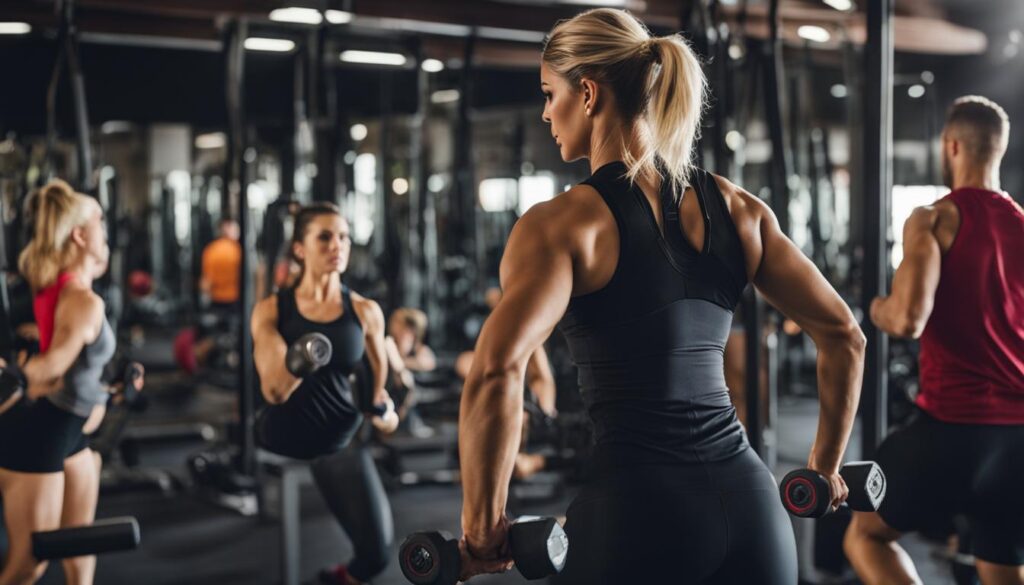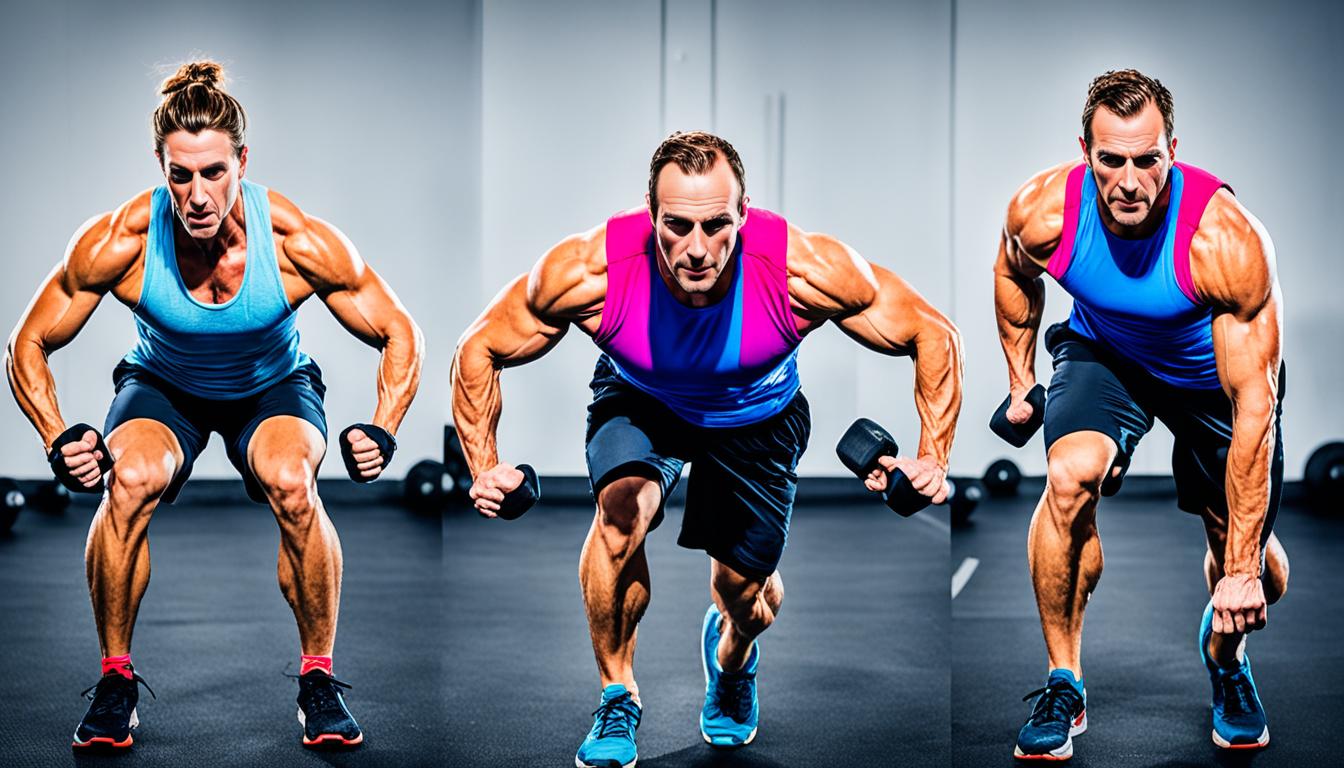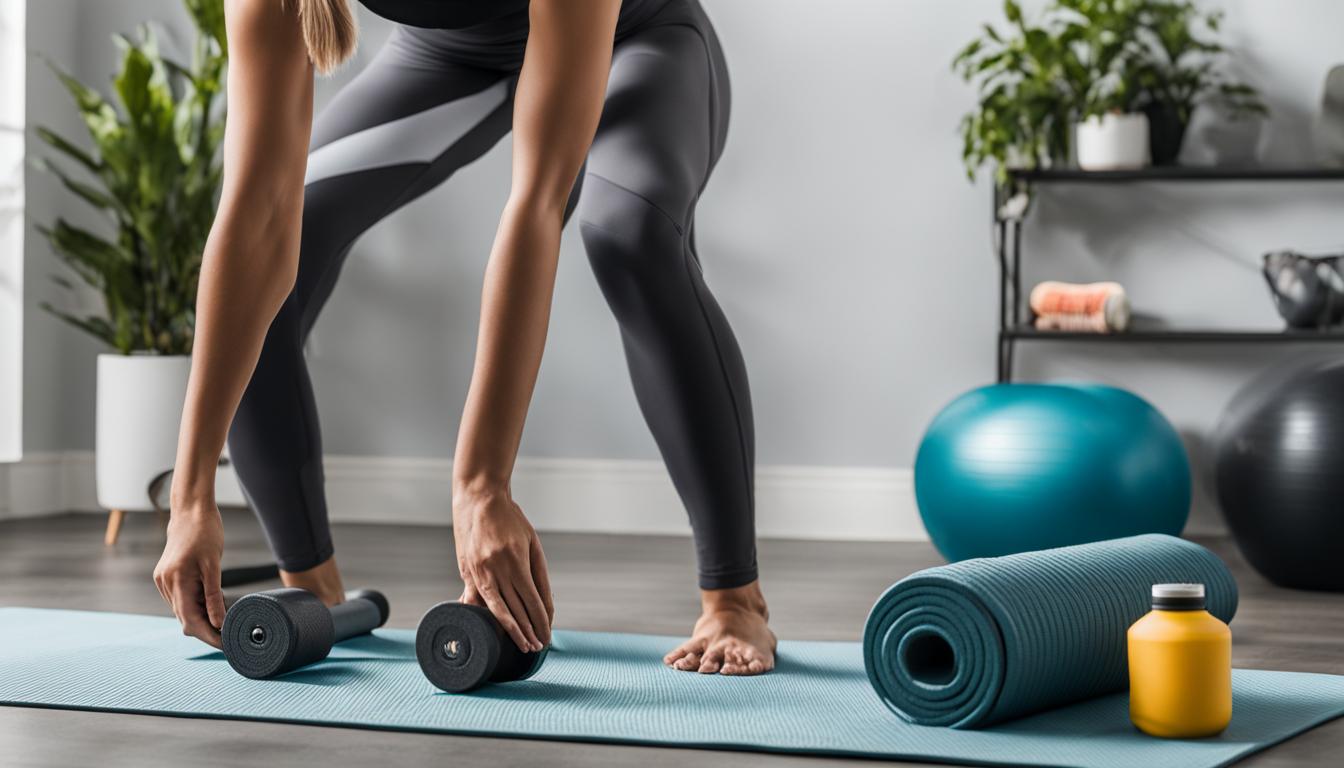If you’re looking for a dynamic way to shed pounds and elevate your fitness, high-intensity interval training for weight loss might be just the ticket. HIIT is renowned for its ability to fire up your metabolism and transform your body’s fat-burning capabilities. With the best HIIT exercises for weight loss, you can enjoy quick, intense workouts that fit seamlessly into your hectic schedule. These fat-burning HIIT workouts are designed to keep you engaged while delivering the results you crave.
Key Takeaways
- High-intensity interval training can significantly enhance your calorie-burning potential.
- Effective HIIT workouts for weight loss are time-efficient and perfect for a busy lifestyle.
- Best HIIT exercises for weight loss focus on full-body movements for maximum impact.
- Fat-burning HIIT workouts stimulate metabolism, continuing to burn calories post-session.
- HIIT can be adapted for any fitness level, providing a scalable challenge as you progress.
The Scientific Basis of HIIT for Fat Loss
High-intensity interval Training, or HIIT, is a powerhouse when it comes to shedding pounds swiftly. By incorporating HIIT training for rapid weight loss into your routine, you trigger a metabolic uproar that continues to burn calories long after you’ve left the gym. Let’s dive into the science behind this effective weight loss strategy.
Understanding Caloric Deficit and Fat Loss
For weight loss to occur, your body needs to burn more calories than it takes in, a state known as a caloric deficit. HIIT is masterful at creating this deficit. It’s not just the high intensity that does the trick; even when you’re resting, your body is hard at work. This makes HIIT workout routines for weight loss a go-to for those seeking notable results.
EPOC: How HIIT Boosts Post-Workout Calorie Burn
Excess post-exercise oxygen consumption (EPOC) is the afterburn effect following an intense workout. HIIT elevates your body’s need for oxygen post-exercise, increasing caloric consumption to replenish energy stores, repair cells, and restore oxygen levels. This means that even after a cardio HIIT workout, your body continues to torch calories.
The Psychological Benefits of High-Intensity Workouts
HIIT isn’t just about accelerating fat loss; it’s also mentally engaging. You’re more likely to stick with a workout regimen when it’s varied and challenging, keeping boredom at bay. The quick and flexible nature of effective cardio HIIT workouts contributes largely to their sustainable allure, making your weight loss journey enjoyable as well as effective.
| HIIT Attributes | Benefits for Weight Loss |
|---|---|
| Short, Intense Workouts | Maximizes time efficiency and calorie burn |
| Increased Post-Exercise Oxygen Consumption | Boosts metabolism and extends calorie burn post-workout |
| Psychological Engagement | Enhances workout adherence, reducing dropout rates |
By mixing short bursts of intense exercise with recovery periods, HIIT keeps you burning fat and coming back for more. It’s the perfect blend of efficacy and excitement, laying a solid foundation for long-term fat loss and overall health enhancement.
Effective HIIT Workouts for Weight Loss
If you’re aiming for fast weight loss, incorporating HIIT workouts into your schedule could be the game-changer you need. High-intensity interval Training, commonly known as HIIT, consists of bursts of maximum effort exercises followed by short recovery periods. Here’s a glimpse into how a well-rounded HIIT weight loss plan could look, helping you achieve the results you’re after.

HIIT workouts for fast weight loss are designed to keep your heart rate up and burn more fat in less time. Below we’ve detailed a series of exercises that can be part of your at-home HIIT sessions. Practice each move with all-out effort for 20 seconds, take a 10-second rest, and then move onto the next. After one round, rest for 1-2 minutes and begin again. Aim for 3 to 5 rounds in total.
- Squats: Target the legs and glutes and boost your lower body strength.
- Lunges: Improve your balance and sculpt your thigh muscles.
- Inchworms: Engage the arms, chest, and core as you walk your hands into a plank.
- Push-ups: A classic move to strengthen the upper body and core.
- Mountain climbers: An intense cardio push to work the entire body.
- Skaters: Boost lateral movements and challenge the legs and core.
Here’s a simple yet effective HIIT workout example to start with:
| Exercise | Duration | Rest | Rounds |
|---|---|---|---|
| Squats | 20 seconds | 10 seconds | 3-5 |
| Lunges | 20 seconds | 10 seconds | |
| Inchworms | 20 seconds | 10 seconds | |
| Push-ups | 20 seconds | 10 seconds | |
| Mountain Climbers | 20 seconds | 10 seconds | |
| Skaters | 20 seconds | 10 seconds |
Remember, consistency is key with any HIIT workouts to lose weight. Pair these workouts with a balanced diet, and you’ll be on your way to achieving your weight loss goals. Keep your movements steady, and always listen to your body—adjusting intensity as needed.
HIIT vs. Traditional Cardio: A Comparison
If you’re considering HIIT cardio workouts as part of your exercise regimen, understanding how it measures up against traditional cardio is paramount. High-Intensity Interval Training (HIIT), known for its fat-burning efficiency, can be a game-changer in your fitness journey, especially with HIIT workout routines for weight loss.
Fat-burning HIIT workouts are not just a trend; they are backed by science to be more effective in many aspects compared to the consistent pace of traditional cardio. Let’s dive into some specific comparisons to highlight why HIIT might be the superior option for your weight loss and fitness goals.
Calorie Expenditure and Time Efficiency
With HIIT, you can say goodbye to long sessions on the treadmill. Scientific studies have established that HIIT can help you burn more calories in a shorter period. This means you can achieve your fat loss targets more quickly and efficiently, freeing up time for other activities or commitments in your life.
Long-Term Metabolic Adjustments
HIIT’s impact extends beyond the workout itself; it uniquely raises your metabolic rate for several hours thereafter. This post-exercise period, often referred to as the ‘afterburn effect’, catalyzes long-term metabolic adjustments that favour fat oxidation over carbohydrate usage, thus improving your body’s efficiency in utilizing fat for energy.
Sustained Muscle Mass and Increased Muscle Gain
While traditional cardio can lead to muscle loss along with fat, HIIT promotes muscle maintenance and even growth. This is essential not only for aesthetic appeal but also because muscle mass plays a critical role in sustaining a high metabolic rate, making it easier to manage your weight in the long term.
As you consider incorporating HIIT into your routine, weigh these benefits against the status quo of your current exercise program. HIIT’s efficient calorie burning, metabolic benefits, and muscle-preserving nature could very well be the pivotal change that propels you toward reaching your weight loss and fitness ambitions.
Beyond the Scale: HIIT’s Impact on Overall Health
When you incorporate HIIT training for rapid weight loss into your routine, you’re embarking on a journey that surpasses mere aesthetics. The powerful benefits of the best HIIT exercises for weight loss extend far beyond the mirror, nurturing your inner well-being and fortifying your health against a spectrum of conditions.
Improving Cardiovascular Fitness
It’s widely known that effective cardio HIIT workouts provide a robust platform for boosting heart health. Through the alternating intensities, your heart learns to operate more efficiently. The sheer intensity of HIIT pushes your cardiovascular system, improving blood flow and heart function—vital steps toward a healthful future.

Support for Type 2 Diabetes Management
One of the subtle yet profound impacts of HIIT is its potential to stabilize blood glucose levels. This training modality can spike insulin sensitivity, which can be an incredible boon for managing type 2 diabetes. By integrating these routines into your life, you may witness a more regulated blood sugar profile—the silent victory in the fight against diabetes.
Cardio HIIT Workouts for Blood Pressure Regulation
Are you aware that hypertension can be effectively managed with a suitable fitness regimen? Enter HIIT—a versatile approach that not only strips away pounds but also helps keep your blood pressure in check. By engaging regularly in challenging cardio HIIT workouts, you can forge a more balanced blood pressure range, an achievement that speaks volumes about your overall health.
Understanding the full impact of HIIT requires looking at the comprehensive health profile it promotes. By stepping into this high-intensity realm, you do far more than shrink your waistline: you ramp up your vitality and arm your body to resist the ailments that challenge countless lives.
Building a HIIT Weight Loss Plan
Embarking on a journey to shed weight can be thrilling, and HIIT workouts to lose weight are a stellar way to jumpstart your efforts. A meticulously crafted HIIT weight loss plan takes more than just high-intensity work; it’s about balance and strategic planning. Let’s break down the essentials of a plan designed to bring you closer to your rapid weight loss goals with HIIT training for rapid weight loss.
It’s important not to merely indulge in random exercises but to follow a holistic approach. Variety isn’t just the spice of life but also the key to a balanced regimen. Including full-body strength exercises is crucial for building muscle while burning fat. But remember, the intensity of HIIT calls for active rest days — a necessity, not a luxury, for recovery and injury prevention.

To create the optimal plan, consider complementing high-intensity sessions with steady-paced cardio and resistance training. This mix not only helps in preserving muscle mass but also boosts metabolic health. Below, you’ll find a sample weekly workout schedule that integrates these components for enhanced fat loss and recovery.
| Day | Workout Type | Focus & Benefits |
|---|---|---|
| Monday | HIIT Training | Jumpstart metabolism, high-calorie burn |
| Tuesday | Resistance Training | Muscle strengthening, enhanced endurance |
| Wednesday | Active Rest | Recovery, light activities such as walking or yoga |
| Thursday | HIIT & Strength Combo | Dual benefits of fat burn and muscle building |
| Friday | Steady-state Cardio | Endurance, steady calorie burn |
| Saturday | Full-body Strength Training | Whole-body muscle toning, increased metabolism |
| Sunday | Complete Rest | Allow full recovery and muscle repair |
Remember, your HIIT weight loss plan should never feel etched in stone — flexibility is fundamental. Listen to your body and adjust as necessary. Switch up workouts to keep things fresh and avoid plateaus. Permit yourself to enjoy the active rest days; they’re there to ensure you can power through the high-intensity days without compromising on efficacy or safety.
Consistency in executing your HIIT plan is pivotal for progressive and sustainable weight loss. Motivate yourself with small milestones and celebrate the victories, no matter how tiny they seem. Every step forward is a step towards a healthier, more energized you.
Key HIIT Movements for Maximum Fat Burn
Embarking on a high-intensity interval training journey for weight loss can be both exhilarating and daunting, but with the right exercises, you’ll find yourself shedding pounds in no time. HIIT is renowned for its effectiveness, and certain key movements stand out when it comes to accelerating fat loss. Here are some of the best HIIT exercises for weight loss that are not only effective but can easily be integrated into your fitness routine.
High Knees: Cardio Intensity with No Equipment
High knees are a simple yet powerful exercise to kick-start your metabolism and enhance your cardiovascular strength. This movement mimics running in place, with an emphasis on lifting your knees as high as possible. It strengthens your legs and core while pumping the heart rate up, making it one of the most effective HIIT workouts for weight loss without the need for any equipment. Try integrating high knees into your routine and watch the calories burn away.
Burpees: The Total Body Fat-Burning Exercise
If there’s one exercise that’s synonymous with HIIT, it’s burpees. This full-body exercise touches upon practically every muscle group, from your calves to your shoulders. By engaging your core, chest, and legs, burpees serve as an efficient way to enhance strength and burn fat. As a staple of effective HIIT workouts for weight loss, incorporating burpees into your workout can significantly help in achieving your fat loss goals.
Jump Squats and Lunge Jumps: Leg-Intensifying Moves
Jump squats and lunge jumps intensify traditional squats and lunges by adding an explosive cardiovascular element to them. Each jump propels you through space, leading to substantial calorie expenditure and muscle engagement. These movements are integral for anyone looking to optimize their high-intensity interval training for weight loss. It’s all about power and precision with these leg-intensifying moves, making them excellent for those aiming to sculpt their lower body while torching fat.
Implementing these key exercises can significantly improve your HIIT regimen’s effectiveness. Remember, consistency is just as important as intensity, so keep at it, and you’ll see the transformative effects of the best HIIT exercises for weight loss first-hand.
Integrating HIIT with Strength Training for Comprehensive Fitness
For those of you seeking to redefine fitness goals, incorporating a HIIT weight loss plan with strength training is the secret to unlocking your full potential. When HIIT workouts for fast weight loss are combined with the muscle-sculpting power of strength training, you get a dual-action approach that not only slashes fat but simultaneously amplifies muscular endurance.
Imagine wielding dumbbells in a heart-pumping interval workout—each lift, squat, and press turbocharged by the HIIT framework. This isn’t just another gym routine; it’s a transformative experience that catapults calorie burning to new heights. As you pivot between high-octane cardio and concentrated resistance moves, you’re forging a path to unrivaled stamina and a rock-solid physique.
But why stop at imagining? Here’s how you can craft a synergy between high-intensity intervals and strength exercises:
- Alternate muscle groups — After a HIIT sprint, work on a non-related muscle group to keep the intensity without burnout.
- Balance load and rest — Ensure optimal recovery by setting a structured ratio of work to rest that allows for muscle repair and growth.
- Embrace diversity — Mix up your HIIT routines with different strength training exercises to target the whole body evenly and avert monotony.
This robust combination promises not just a leaner frame, but also a fortified one, ready to tackle life’s daily demands with vigour and vitality. With a well-orchestrated HIIT weight loss plan, each session brings you closer to a personal pinnacle of fitness, where fast fat loss meets solid muscle gain.
Pre-HIIT Safety Tips & How to Start the Right Way
Embarking on a journey with HIIT workout routines for weight loss can be exhilarating, but ensuring a safe start is crucial for your health and success. Let’s dive into some essential safety tips that will help you begin your effective cardio HIIT workouts on the right footing. Appropriate intensity levels, rest periods, and low-impact alternatives create a solid foundation for a safe and effective fitness routine.
Selecting Appropriate HIIT Intensity Levels
When you start with HIIT, it isn’t about diving in at the deepest end—it’s about finding the right depth to challenge yourself without risking injury. Your fitness level should guide the intensity of your workouts. If you’re new to HIIT, it’s wise to begin with less complex moves and gradually increase the difficulty as your stamina and strength improve. Keeping each work session under 30 seconds allows you to maintain the high-intensity effort HIIT is known for.
Understanding the Importance of Adequate Rest Periods
Rest is not a sign of weakness; it’s a part of the strategy. Rest periods are just as critical as the high-intensity intervals—they allow your body to recover enough to give your maximum effort in the next round. A good rule of thumb is to provide yourself with a rest period that’s equal to or slightly longer than your work session, so your heart rate can come down and you can catch your breath. Remember, it’s this pattern of intensity and recovery that makes HIIT such an effective method for weight loss.
Low-Impact Alternatives for Joint Protection
If you have existing joint problems or just want to reduce the impact on your joints, there’s still a HIIT workout for you. Low-impact exercises like cycling, swimming, or even walking intervals can get your heart rate up without stressing your joints. Alternatives such as these ensure that everyone has the opportunity to benefit from HIIT’s fat-burning properties.
Before you jump into your next workout session, consider these guidelines for a balanced HIIT routine:
| Exercise Type | Work Duration | Rest Duration | Intensity | Impact Level |
|---|---|---|---|---|
| Bike Sprints | 30 Seconds | 45 Seconds | High | Low |
| Swimming Intervals | 30 Seconds | 30 Seconds | Moderate | Low |
| Jumping Jacks | 20 Seconds | 40 Seconds | High | Medium |
| Walk/Jog Intervals | 1 Minute | 2 Minutes | Moderate | Low |
Conclusion
If you’re seeking a potent method to trim down and elevate your overall health, look no further than High-Intensity Interval Training. The journey to fat loss using HIIT cardio workouts to lose weight is challenging, yet highly rewarding. By incorporating these workouts into your routine, you benefit from the high calorific churn during and after your sessions—thanks to the afterburn effect. What’s more, the adaptability of HIIT means you can often find the best HIIT exercises for weight loss tailored to your preferences and capabilities, making it an ideal strategy for sustainable fitness and fat loss.
Summarizing The Fat Loss Benefits of HIIT
HIIT stands out not only for the significant caloric burn per session but also for the remarkable efficiency in which it operates. Its structured bursts of intense activity intertwined with brief recovery periods stimulate your metabolism in a way that continues to burn calories long after your workout is complete. By harnessing the advantages of these meticulously designed routines, you lay the groundwork for an efficient and effective fat-loss journey.
Recommendations for Long-Term HIIT Practice
To maintain momentum and maximize results, it is essential that you incrementally increase the intensity of your HIIT workouts. Progress might be thrilling, but always pair it with sufficient rest to rejuvenate yourself for future sessions. Remember, a well-structured regimen that balances exertion with recovery is central to realizing the long-term benefits of HIIT. Balancing exertion with recovery can aid in leveraging the impactful, lasting results attributed to HIIT.
Professional Guidance and Personal Responsibility in Fitness
While HIIT offers a streamlined pathway to fat loss, the guidance of fitness professionals can be invaluable. These experts can help tailor your HIIT regimen to fit your unique health requisites and fitness thresholds, ensuring you work out efficiently and safely. Furthermore, take ownership of your fitness journey. Embrace tools like smart scales to keep track of your progress and stay motivated as you explore the dynamic world of HIIT. By combining professional insight with personal dedication, you lay a robust foundation for your fitness endeavours.
FAQ
What are some effective HIIT workouts for weight loss?
Effective HIIT workouts for weight loss typically include a mix of bodyweight exercises such as squats, lunges, push-ups, and high-intensity movements like burpees, mountain climbers, and high knees. These exercises are performed in short, intense bursts with brief rests in between.
How does HIIT contribute to weight loss?
HIIT contributes to weight loss by creating a caloric deficit through intense bursts of exercise that burn a significant number of calories. Additionally, the afterburn effect, or excess post-exercise oxygen consumption (EPOC), leads to increased calorie burning for hours after the workout.
What psychological benefits does HIIT offer for weight loss?
The psychological benefits of HIIT include its dynamic nature and shorter workout duration, which keep the routine engaging and manageable. This can lead to increased consistency and a reduced likelihood of giving up on one’s fitness journey.
How does HIIT compare to traditional cardio in terms of weight loss?
HIIT tends to burn more calories in less time compared to traditional steady-state cardio, making it a more efficient option for those with limited time. It also helps increase metabolism and muscle mass, which are beneficial for long-term weight maintenance.
Can HIIT workouts improve overall health besides aiding in weight loss?
Yes, HIIT workouts can significantly improve cardiovascular health, aid in the management of blood sugar levels, and assist in regulating blood pressure. They also enhance oxygen consumption and insulin sensitivity, contributing to overall well-being.
How can I build a HIIT weight loss plan?
A balanced HIIT weight loss plan should include a variety of workouts, such as full-body strength training and high-intensity interval sessions, combined with periods of active recovery to prevent injury. It’s also recommended to mix in steady-state cardio to ensure a comprehensive approach to fitness.
What are some key HIIT movements for maximizing fat burn?
Key HIIT movements that maximize fat burn include high knees for cardio intensity, burpees for full-body engagement, and jump squats and lunge jumps for strengthening and toning the legs while significantly increasing calorie expenditure.
How can I safely integrate HIIT with strength training?
To safely integrate HIIT with strength training, start with exercises at an appropriate intensity level and include sufficient rest days to allow for muscle recovery. You can include equipment like dumbbells for resistance-based HIIT exercises, progressively increasing the difficulty as you become stronger.
What should I consider before starting HIIT to prevent injury?
Before starting HIIT, ensure you select exercises that match your current fitness level. Focus on maintaining proper form, choose the right intensity, and incorporate adequate rest periods to sustain energy levels while preventing overtraining and injury.
What are low-impact HIIT alternatives for those with joint pain?
Low-impact HIIT alternatives for individuals with joint pain include exercises like cycling, swimming, or using an elliptical machine. These activities provide the benefits of high-intensity workouts while minimizing stress on the joints.





